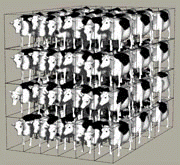Animal Science, Department of
Date of this Version
1986
Abstract
Breeding objectives are largely determined by market requirements. In the tropics the overall breeding objective can be considered in terms of growth, reproductive rate, carcass quality, adaption and temperament. Growth rate is a simple efficient selection trait. Reasons why potential increases in mature size are not as disadvantageous as in temperate areas are discussed. Reproductive performance has been less important in harsh than benign environments because of the later age of turnoff and higher drought risk of fertile cows. Current market trends towards younger slaughter stock highlight the need to identify marker traits in bulls for cow fertility. Adaptive traits have been defined for heat tolerance, parasite and disease resistance. It is not yet clear under what conditions direct selection for adaption is likely to be advantageous. It may be appropriate were genotype - environment interactions need to be considered.



Comments
Published in 3rd World Congress on Genetics Applied to Livestock Production, edited by Gordon E. Dickerson and Rodger K. Johnson, 4 vols. (Lincoln: University of Nebraska Institute of Agriculture and Natural Resources, 1986). Copyright © 1986 Board of Regents University of Nebraska.